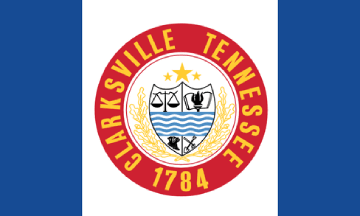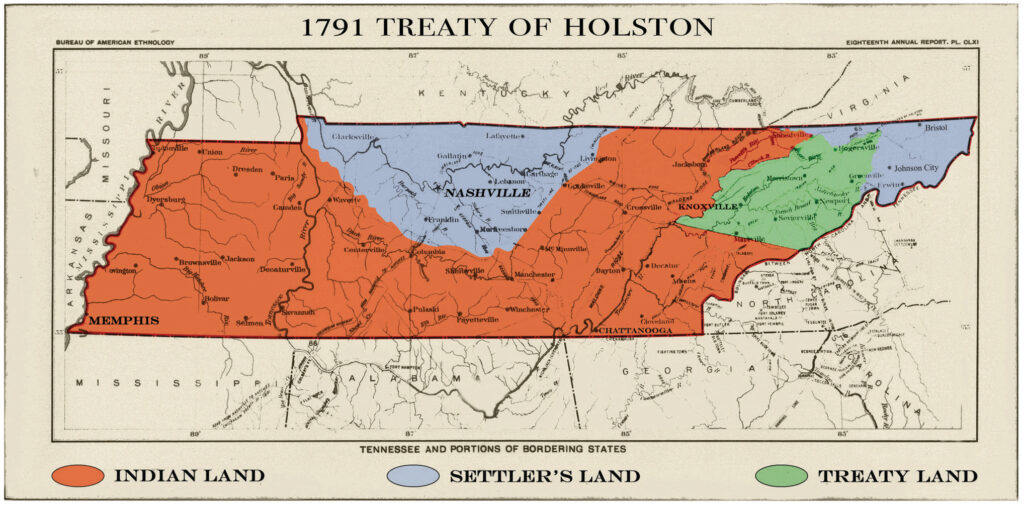
By Meghan E. Gattignolo
It’s much easier to find remnants of the 19th century in Clarksville than the 18th. Most of the buildings on Franklin Street were built shortly after the Civil War. Plenty of newspaper articles from the last half of the 19th century can be found in archives online. Not to mention, Fort Defiance keeps Civil War-era stories available for us to peek in at once in a while. Sometimes we forget that Clarksville is older than 1860.
While Clarksville still bears many marks and places that existed in the 19th century, some pieces of the 18th century still stand, if you know where to look. Sevier Station near Fort Defiance and Riverview Cemetery (formerly City Cemetery) on the hill overlooking the Cumberland – the only cemetery in Clarksville where Americans from every conflict from US history are buried – are two relics from Clarksville’s beginnings.
One of the earliest established cities in Tennessee, Clarksville has existed as a town since 1784. John Montgomery, veteran of the Revolutionary War, immediately recognized the potential of the land that would become Clarksville during a scouting expedition. But what did Clarksville look like in 1784? Would we recognize any of it today? Here are 4 features that defined Clarksville in 1784.
- Tennessee County, in North Carolina
Clarksville is the second-oldest city in Tennessee, predating the state itself. If you do your own historical research about Clarksville, you may get frustrated. Why? Because in 1784, Clarksville was established in Tennessee County – in the state of North Carolina. It wouldn’t be long before Tennessee County would become Montgomery County, but it would be 12 years before Clarksville would be in the state of Tennessee. This makes reading and understanding history a little confusing sometimes. Occasionally, people are described as being from North Carolina, when in reality, they were born in modern-day Tennessee.

The United States of North America, with the British & Spanish territories according to the treaty of 1784
Library of Congress, Prints & Photographs Division
- The Western Frontier
It’s hard to imagine now, but in the early days of the United States, the lands between the Appalachian Mountains and the Mississippi River were the wild west. Prairies, grasslands, rolling hillsides and untamed woods defined the landscape of early Tennessee. With Great Britain in charge, the land was off limits. After pushing the British out, the new Americans did what they wanted. Homesteads and land grants were awarded to officers of the Revolutionary War, and pretty soon after the close of the war, people were spreading out and taking their families west. The next great barrier was the mighty Mississippi River, one that would be thrown wide open during the course of the following century.
- Battles with Original Residents
A harsh truth about Clarksville’s beginnings is the multiple and persistent conflicts that existed between the settlers and the nearby tribes. Indigenous people have utilized the land that is now Clarksville for thousands of years. In 1784, local tribes like the Cherokee, Chicasaw and Choctaw were present in the area when settlers began to move in. Following the French and Indian War in 1763, the British agreed that settlers would not move further west than the Appalachian Mountains. The Americans decided that agreement didn’t apply to their new government.
Local tribes were motivated to band together to defend their land, and many encroaching settlers met brutal ends. Famously, early Clarksville settler Valentine Sevier – the brother of Nashville co-founder John Sevier – experienced the loss of nearly his entire family during an attack while he was away from home. In 1784, you would move to Clarksville at your own risk.

This map shows how most of present-day Tennessee was owned by Native American tribes after the 1791 Treaty of Holston
Tennessee State Museum
- Homestead Disputes
Even in 1784, developers were anxious to make a buck from real estate in Clarksville. If you live in Clarksville today, take a quick peek outside your door. Chances are that your home sits on land that was once a family farm or homestead. Many incoming settlers bought land near Clarksville from speculators. In a time when communications were excruciatingly slow, doing business with anyone could be tricky. Thomas Dunbar bought land to build a homestead for his family in 1784, but would not receive a land deed. The speculator he bought the land from just didn’t have one.
After almost a decade of living on his homestead with his family, Dunbar lost most of his land when another man realized he had no proof of purchase. Another deed was drawn up and Dunbar’s property was sold off. Land disputes like this were common at a time when many claims overlapped, or people just had no hard evidence they even owned the land in question. Always get a receipt!
This year, Clarksville turns 240 years old. We can only imagine John Montgomery would be pleased to see how his little station on the hill has continued to thrive through almost two and a half centuries with no end in sight. Also, don’t forget to celebrate the Museum’s 40th anniversary this year by stopping by and checking out our exhibits. Get reacquainted with your local source for Clarksville history!
Resources:
https://history-maps.com/story/American-Revolutionary-War/event/Western-theater-of-the-American-Revolutionary-War
https://www.jstor.org/stable/45331624?seq=4
http://www.mchsociety.org/History.html

Meghan E. Gattignolo is a freelance writer and longtime Clarksville, TN resident. She loves to obsess about historical subjects and annoy her family daily with unsolicited random facts. Meghan holds a History B.A. from Austin Peay State University and lives in town with her husband and two children.